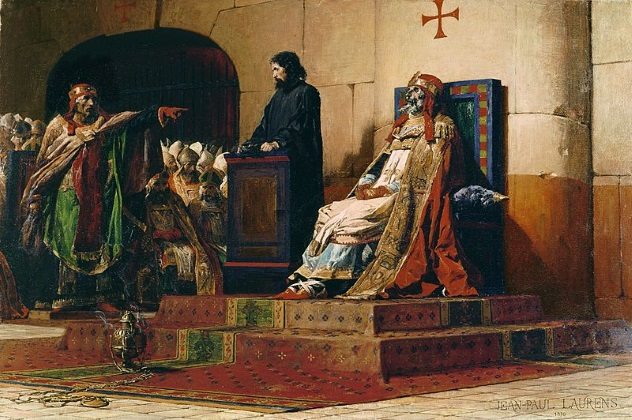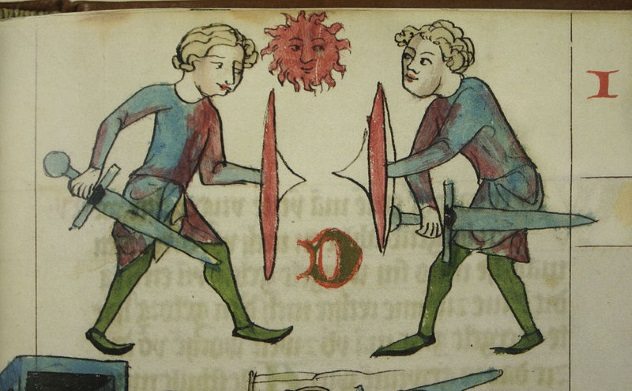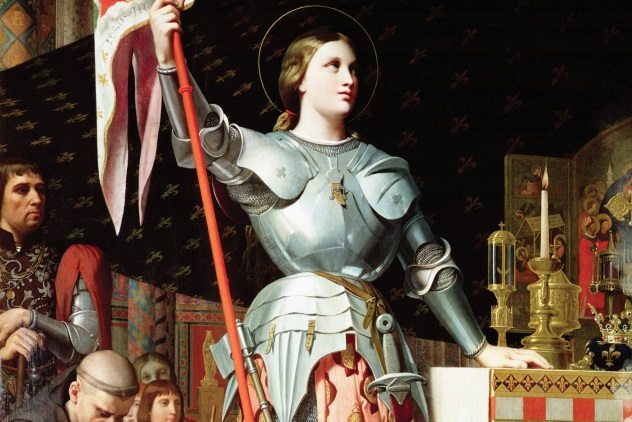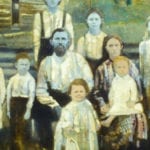10 Rose De Savage
On a January morning in 1280, a group of men kidnapped a woman named Rose de Savage while she was walking to church. The band’s leader, John de Clifford, moved Rose to his house and made her undress. He then raped her, and after he was finished, he locked Rose in an upper-story bedroom. Over the next 21 months, Rose was held prisoner in the same room, forbidden to leave. In November 1282, on St. Martin’s Day, Rose was able to escape from de Clifford’s house by jumping out a window. After Rose was safe, a trial against John de Clifford was organized for “rape and breach of the king’s peace.”[1] In court, de Clifford denied the charges. In fact, Rose was the one who ended up going to jail. Since she didn’t provide the exact dates of her rape and imprisonment, her accusations were considered false. After Rose’s imprisonment, a jury did eventually find John de Clifford guilty, but he was let off with a fine.
9 Rolandino Ronchaia
Rolandino Ronchaia was a hermaphrodite who lived in Venice in the 14th century. Although he was born with a penis, Ronchaia grew full breasts and had a very feminine appearance. As an adult, he married a normal woman, but the marriage fell apart because he couldn’t have an erection. After his wife left him, Ronchaia moved into a relative’s house in Padua.[2] Tempted by his feminine features, another guest made a pass at Ronchaia and had sex with him. From that point on, Ronchaia decided to start living as a woman. He changed his name to Rolandina, moved back to Venice, and worked as a female prostitute. In Venice, Ronchaia attracted a huge number of clients, none of whom knew he was a man. Unfortunately, Ronchaia attracted the eyes of city authorities, too. He was brought to trial on a charge of sodomy, and though the authorities were aware of his condition, Ronchaia was sentenced to be burned alive.
8 Pandonus
Medieval Europe was a rabidly anti-Semitic place, and this attitude was reflected in the legal system as well. In many places, Jews were banned from working in most professions, had to wear special clothes, and couldn’t hold public office. They were also forbidden from marrying Christians. Whether they were married or not, Jews who had intimate relations with Christians were accused of adultery. In 14th-century Avignon, for example, a Jewish man named Pandonus was arrested and accused of adultery for having sex with a Christian woman. Pandonus confessed to the crime, but the Italian jurist Oldradus de Ponte logically argued that, since the couple wasn’t married, Pandonus didn’t commit adultery and shouldn’t be punished.[3] The two judges who presided over the case thought differently. Pandonus was castrated, and his genitals were put on the doors of the royal palace as a warning to other mixed couples.
7 Pope Formosus
In January 897, Pope Stephen VI called up a trial against Pope Formosus, the pope who ruled before his predecessor, Boniface VI. Formosus had already been dead the past nine months, but Stephen had his corpse dug up and put on a chair in the courtroom. The late pope was accused of three different crimes: perjury, ambition to seek the papacy, and breaking Church law.[4] To the surprise of nobody there, Formosus lost his case. His time as pope was ruled invalid, rendering all the appointments and legal measures he made null and void. The fingers he used to make blessings were cut off, and his body was tossed into the Tiber River. Stephen hoped the bizarre trial would help him gain favor with an old enemy of Formosus, but most Romans weren’t happy with it. The clergymen whose appointments were annulled were furious, and a hermit is said to have rescued Formosus’s body and reburied it. In November, after a new pope took office, a second trial redeemed Formosus’s reputation and gave his body an honorable burial.
6 Count Gero Of Alsleben
Trial by combat, first practiced by Germanic peoples, was sometimes used to settle disputes in medieval Europe. Not everybody was allowed to fight, but there are records of monasteries fighting other monasteries and wives fighting their husbands. Generally, the loser would be executed, but this didn’t always happen. In 979, the royal court in the Holy Roman Empire set up a trial by combat between Count Gero of Alsleben and a Saxon named Waldo.[5] The historical record isn’t clear about why the men fought, but Waldo brought some kind of charge against Gero, and Gero was arrested. In the battle, Gero cut Waldo’s neck, but Waldo disabled Gero with a blow to the head, winning the fight. Right after beating Gero, however, Waldo collapsed dead. You’d think dying would have ruined Waldo’s victory, but the judges still insisted that the dead man won. Since Gero was the technical loser, Emperor Otto II ordered for the count to be decapitated.
5 Stadelin Of Boltigen
Stadelin was a Swiss farmer who lived in the municipality of Boltigen sometime between 1392 and 1406. One year, when Stadelin’s crop yield was better than his neighbors, rumors spread that he was a sorcerer. It was said that he only had such a good yield because he used magic to transport crops from other people’s fields. He could also supposedly control the weather and caused a local woman to miscarry seven times in a row. Eventually, Stadelin was arrested and confessed to being a sorcerer after being tortured.[6] He claimed that he was in contact with demons, who would summon thunderstorms after he tossed a black chicken up into the air. As for his neighbor’s trouble with bearing children, Stadelin said her infertility was the result of a lizard he buried on her property. Stadelin also revealed that his wife was a witch and recommended that the authorities not believe her if she said otherwise. For his confession, Stadelin was burned at the stake, while his wife got the same punishment for not confessing.
4 John Rykener
John Rykener was a 14th-century Londoner who lived a secret double life. He was a playboy who had sex with countless women, but he also dressed up as a woman and worked as a prostitute under the name Eleanor. In December 1395, John was picked up by city officials after being caught with a client in a stall in the street.[7] The client told authorities that he paid for sex with John but had no idea that John was biologically male. John, dressed as Eleanor, admitted that he was a cross-dressing prostitute. He then gave a pretty embarrassing list of other men he’d slept with for money. Three of John’s clients were aristocratic scholars. Many of the others were chaplains, friars, and priests. John seemed to have a thing for holy people, because he also slept with nuns for free (while dressed as a man). Sadly, there aren’t any records about what happened to John after his arrest. If he wasn’t let go for his embarrassing testimony, he was probably convicted of sodomy.
3 Girolamo Savonarola
In late 15th-century Florence, the Dominican preacher and reformer Girolamo Savonarola was one of the most powerful men in the city. He attacked the government and the Catholic Church and claimed to be a prophet in touch with God. In 1494, Florence became a democratic republic, and Savonarola became its new leader. In 1497, Savonarola was excommunicated by the pope for his rebellious behavior and preaching. The next year, a rival named Francesco da Puglia challenged Savonarola to a trial by fire to prove that the pope was correct to banish him.[8] The logic of the trial was this: If Savonarola could walk through fire without being burned, then it would show that God was on his side and that the pope and Savonarola’s critics were in the wrong. The trial was held on April 7. A crowd gathered to watch the spectacle, but Savonarola and his supporters ended up arguing with the other side until a thunderstorm broke out and put out the fire. After this fiasco, Savonarola was arrested, confessed to being a false prophet under torture, and was sentenced to hang with two of his supporters.
2 Joan Of Arc
Nearly everybody has heard about Joan of Arc and her trial and execution. Less known is Joan of Arc’s retrial, which was held more than two decades after her death. Joan’s original trial in 1431, while she was alive, was quite complicated. There were originally 70 accusations against her, and though these were dropped to 12, she was more or less burned at the stake for being a heretic.[9] In 1450, the king of France called for an investigation into Joan’s trial. Over the next couple of years, it was found that there were a bunch of technical problems with the case. The English had a great influence on the trial, which was held in the then-English-controlled city of Rouen, so it wasn’t exactly a fair one. By 1455, Pope Calixtus III authorized a posthumous retrial. After some eight months, the court finally reached a verdict. The 12 original accusations against Joan of Arc were ruled fraudulent, giving her an acquittal on her heresy charge. Perhaps the Church was kind of late on this one, but Joan’s family and supporters were quite grateful that her reputation was formally restored.
1 The Leprosy Scare Trials
In medieval times, leprosy was thought to be highly contagious. Medieval Europeans were very paranoid about catching the disease, so lepers were shunned and segregated from mainstream society. Lepers were not only considered unclean but also suspicious and untrustworthy. In spring 1321, a story began to spread in Southern France that lepers were plotting to poison wells and infect the entire country with leprosy.[10] After everybody had become infected, the leper conspirators then would overthrow the government and take control of France. By brutally torturing lepers, the authorities uncovered that Jews and a Muslim king were in on the plot, too. Of course, the entire story was fake, but King Philip V ordered that all the country’s lepers be arrested and put on trial for treason. Hysterical mobs killed lepers with impunity, while those who actually got trials were tortured and burned at the stake. By the end of the year, when the frenzy had largely subsided, thousands of lepers had died in the massacres and trials. Nobody in power bothered to apologize until 1338, when the pope, then centered in the French city of Avignon, acknowledged that the lepers were innocent. Tristan Shaw keeps a blog called Bizarre and Grotesque, where he writes about folklore, paranormal phenomena, and unsolved crime.
























